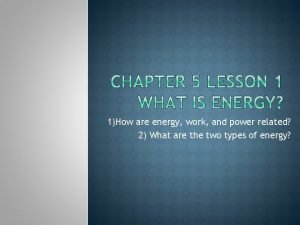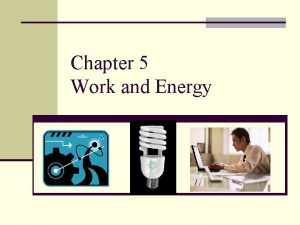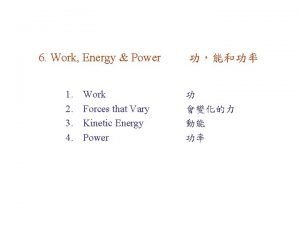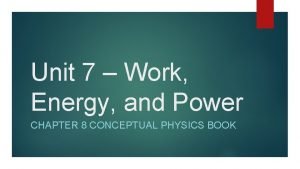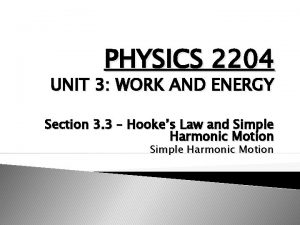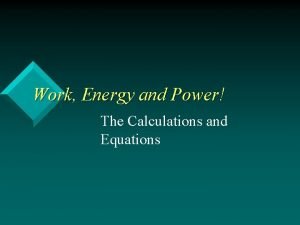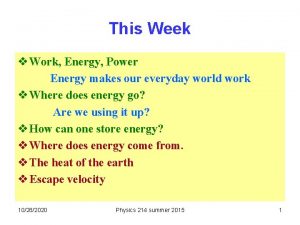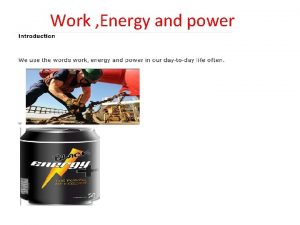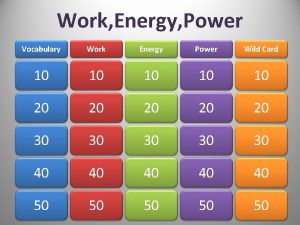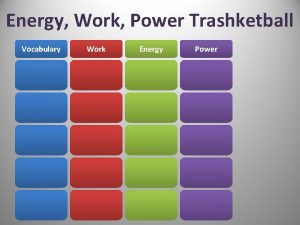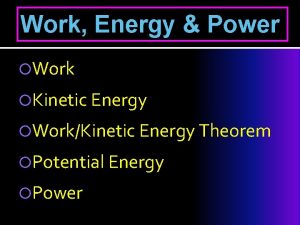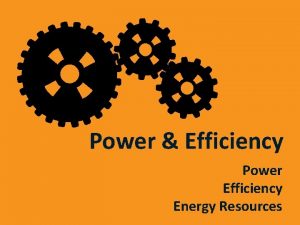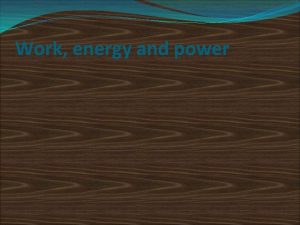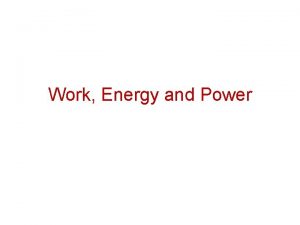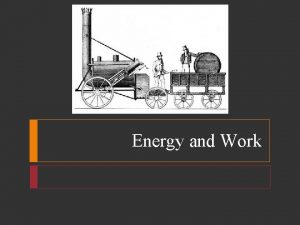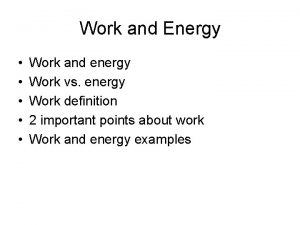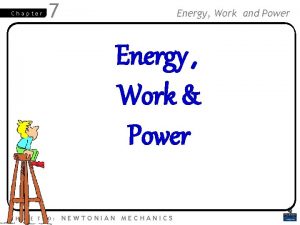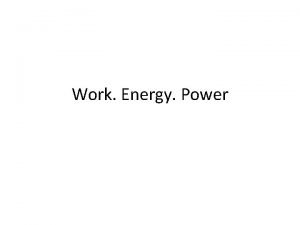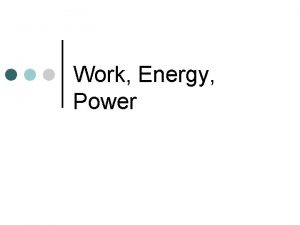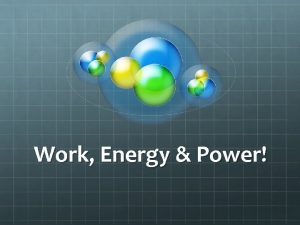Energy Work and Power Energy and Work n







![Power n Power is the rate at which work is done [N. m] , Power n Power is the rate at which work is done [N. m] ,](https://slidetodoc.com/presentation_image/3834d5cf052a93d64090bf67950ab280/image-8.jpg)

















- Slides: 25

Energy, Work and Power

Energy and Work n Energy is the ability to do work ¨ Ex. Kinetic, Thermal, Gravitational, Elastic, Chemical, Electric, Magnetic, Radiant… n Work is the transfer of energy



James Prescott Joule (1818 – 1889): - English physicist - Discovered relationship btw. heat & mechanical work (energy) - Conservation of Energy Theorem


Pg 218
![Power n Power is the rate at which work is done N m Power n Power is the rate at which work is done [N. m] ,](https://slidetodoc.com/presentation_image/3834d5cf052a93d64090bf67950ab280/image-8.jpg)
Power n Power is the rate at which work is done [N. m] , [J] Joule [W] watt [s] second James Watt (1736 – 1819): - Scottish inventor/mechanical engineer. - Improved the efficiency of steam engines. - Introduced horse power (750 watts).

n If a hair dryer does 3000 J of work to heat the air every two seconds, what is its power?

n A 613. 0 kg mass is placed on a forklift that can generate 950 W of power. What is the constant speed of the forklift while lifting this load?

n A HD TV consumes 5. 0 k. W∙h of energy in 30 minutes. ¨ What is its power? ¨ How much does it cost to watch TV for 2 hours if the cost of electricity during peak time is $0. 12/ k. W∙h

Mechanical Energy

Mechanical Energy is a combination of two fundamental types of energy: n n

Mechanical Energy is a combination of two fundamental types of energy: n Kinetic energy (the energy of motion) n Potential energy (energy that is stored) - Gravitational Potential energy

Kinetic Energy n n The kinetic energy of an object of mass m, in kg, and speed v, in m/s:

Kinetic Energy The work done by the net force causes a change in speed n The kinetic energy of an object of mass m, in kg, and speed v, in m/s: n

Gravitational Potential Energy n Ex: A mass m is lifted from a height h 1 to a height h 2 at a constant speed.

Gravitational Potential Energy n “stored energy” in an object at a particular height w. r. t. a reference point. Ex: A mass m is lifted from a height h 1 to a height h 2 at a constant speed.

Gravitational Potential Energy n The gravitational potential energy Eg of an object of mass m, in kg, that is at height h, in m, above the reference point is: n g = 9. 8 m/s 2

Gravitational Potential Energy n The gravitational potential energy Eg of an object of mass m, in kg, that is at height h, in m, above the reference point is: n g = 9. 8 m/s 2

W. E. T. (Work-Energy Theorem) n The total work done on an object equals the change in the object’s kinetic energy OR gravitational potential energy, but NOT BOTH.

Ex 1: What happens to the kinetic energy of an object when work is done on it?

Ex 2: Calculate the work done to speed up a 1500 kg Honda Civic: a) From rest to 20 km/h b) From 80 km/h to 100 km/h

Ex 3: What role does gravitational potential energy play in the production of electricity by Ontario Power Generation?

Ex 4: Ontario Power Generation at Niagara Falls operates under a normal head of about 55 m (height from which water falls). If about 4. 54 x 108 kg of water falls every minute, how many mega-joules of energy are created by the falling water in a hour?
 Real power and reactive power
Real power and reactive power Work, power and energy activities
Work, power and energy activities Work definition physics
Work definition physics How are work and power related
How are work and power related Work power energy and machines
Work power energy and machines Definition of work power and energy
Definition of work power and energy Work power and energy
Work power and energy Jenis usaha apa
Jenis usaha apa Chapter 4 section 1 work and machines answer key
Chapter 4 section 1 work and machines answer key 0kei0
0kei0 Unit of resistivity
Unit of resistivity Physics 2204 unit 3: work, power, energy
Physics 2204 unit 3: work, power, energy Work energy power equations
Work energy power equations Kinetic energy formula
Kinetic energy formula Physics 03-01 work and the work-energy theorem
Physics 03-01 work and the work-energy theorem Section 2 describing energy worksheet answers
Section 2 describing energy worksheet answers Energy energy transfer and general energy analysis
Energy energy transfer and general energy analysis Energy energy transfer and general energy analysis
Energy energy transfer and general energy analysis Solar power satellites and microwave power transmission
Solar power satellites and microwave power transmission Potential power
Potential power Explain dispersive power of grating
Explain dispersive power of grating Flex28024a
Flex28024a Power of a power property
Power of a power property Chain rule範例
Chain rule範例 Power angle curve in power system stability
Power angle curve in power system stability Power bi power point
Power bi power point



